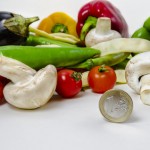The butternut squash is a fruit belonging to the Cucurbita Moschata family; other members of this family include pumpkin, courgette and cucumber. The smooth tan exterior hides a buttery orange flesh which is sweet and nutty. Delicious roasted, toasted, mashed or pureed in soups.
This recipe makes a delightful Autumn supper; it is quick and easy and packed full of nutrients.
Skills Check
Follow a recipe; follow food safety & hygiene rules; tidy away; chop using bridge/claw technique safely; use a vegetable peeler safely; crush garlic; use a jug to measure liquids; use the hob | blender (with adult supervision); season to taste.
Allergens
Celery | May Contain Gluten
(Please note the allergens listed are indicative only. Allergens vary depending on brand; check the labels on the products you use.)
Equipment
Knife, chopping board, vegetable peeler, saucepan, blender, measuring jug, garlic crusher, wooden spoon, kettle.
Ingredients (serves 6, or 12 as a taster):
- 2 cloves of garlic
- 1 carrot, peeled and chopped
- 1 medium onion, peeled and chopped
- 1 stick of celery, chopped
- 1 butternut squash, peeled, de-seeded and chopped
- 2 pints of vegetable stock
Optional - Creative Corner!
- Pinch of ground cinnamon and a pinch of dried chilli flakes
- A swirl of creme fraiche
- A mixture of pumpkin and sunflower seeds
- Sprigs of herbs, such as parsley
Method
- Add the chopped garlic, onion, carrot and celery with a splash of olive oil to a large saucepan and cook on a medium heat for 10-15 minutes until soft.
- Next add the chopped butternut squash.
- Add the stock to just cover everything and simmer until the vegetables are tender, tasting and seasoning as you go.
- Blitz your soup using a blender.
- Serve your soup, piping hot, and garnished with your choices of toppings from the Creative Corner.
So thinking about Super Squash-y Soup ...

Vegetables are so good for us! Low in fat, sugar and calories and high in vitamins and minerals.
Nutritional Information
| - | Energy | 284kJ / 70kcal | 3% |
| Low | Fat | 2.3g | 3% |
| Low | Saturates | 0.3g | 1% |
| Low | Sugars | 6.1g | 7% |
| Low | Salt | 0.8g | 13% |
per 271g serving
% of an adult's reference intake
Typical values per 100g: Energy 105kJ / 26kcal
Notes
A traffic light system is used on nutrition labels to make it easier to see which foods and drinks are lower in calories, fat, sugar and salt. Try and choose more ‘greens’ and ‘ambers’ and fewer ‘reds’, and stick to smaller portions of ‘reds’.
Just because a recipe or a food has a red traffic light doesn’t mean you shouldn’t eat it. Understanding why a food or recipe might have a red light can be helpful. For example oily fish is high in total fat and so any recipe containing oily fish is likely to be ‘red’ for fat. But it is recommended that we eat oily fish at least once a week because the type of fat it contains is beneficial for our health.
% Reference Intakes are also shown. Reference Intakes are guidelines about the approximate amount of particular nutrients and energy required for a healthy diet (based on an average-sized woman doing an average amount of physical activity). Most children will require less than these Reference Intakes. The contribution of one serving of a food or drink to the Reference Intake for each nutrient is expressed as a percentage.




